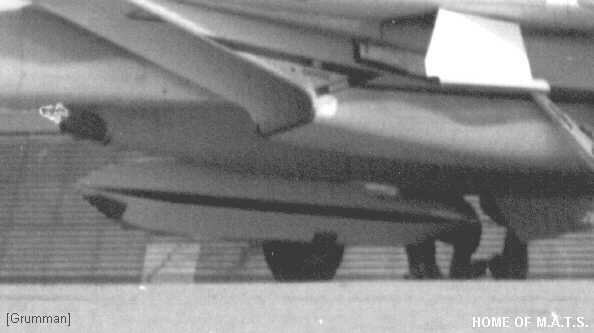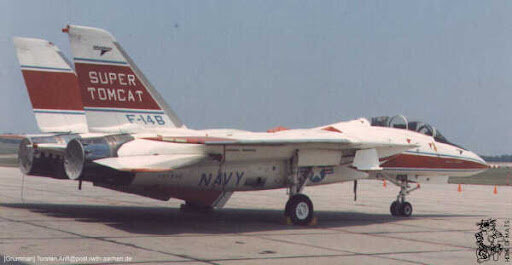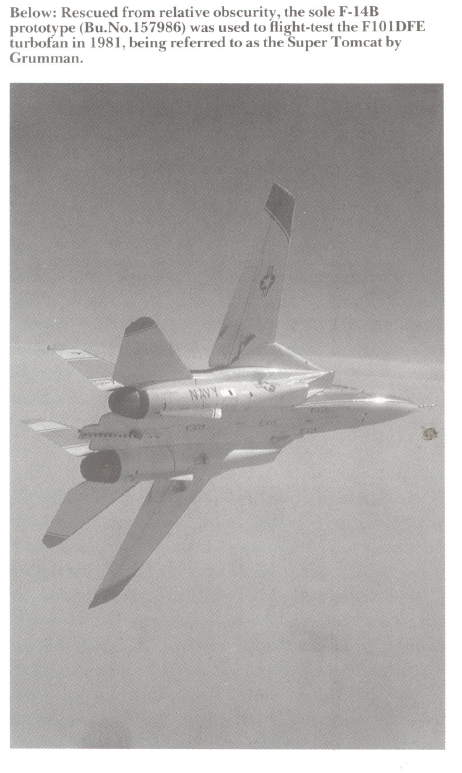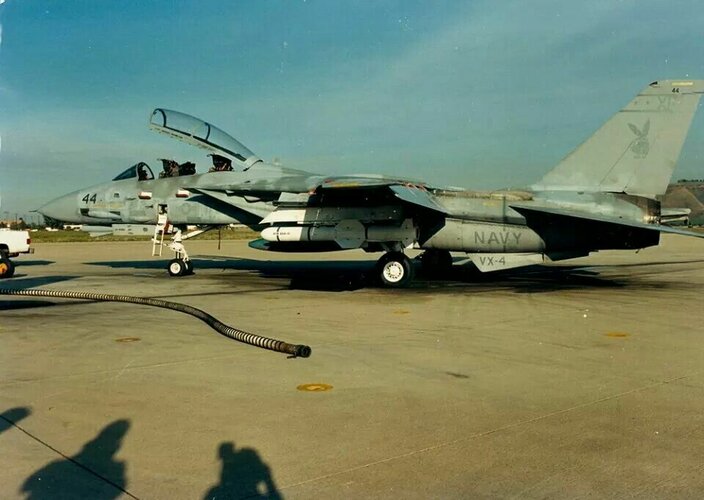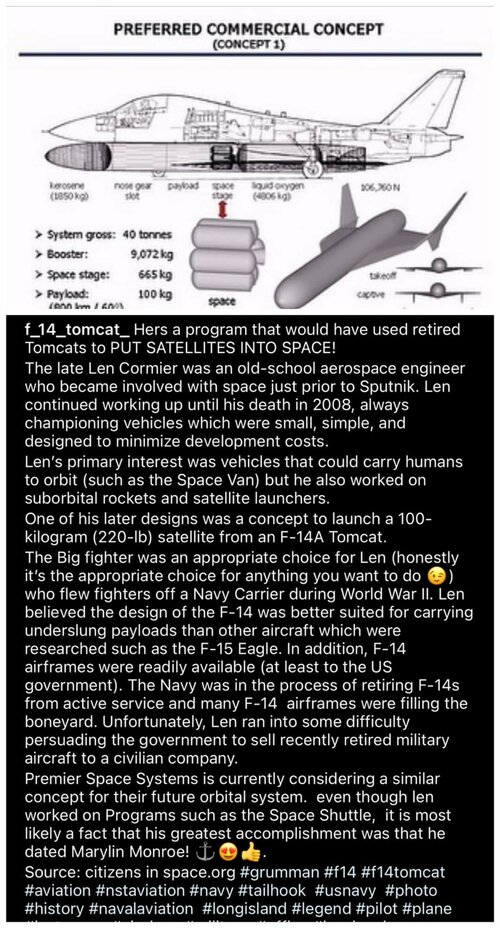I knew of the proposal but that image is a new one to me. Nice find.
You are using an out of date browser. It may not display this or other websites correctly.
You should upgrade or use an alternative browser.
You should upgrade or use an alternative browser.
F-14 Tomcat Projects
- Thread starter Sundog
- Start date
- Joined
- 9 October 2009
- Messages
- 21,927
- Reaction score
- 13,526
I'd have to disagree with you there. TARPS was only really ever meant as a stopgap.
Manuducati
ACCESS: Secret
- Joined
- 25 November 2020
- Messages
- 328
- Reaction score
- 1,056
- Joined
- 3 June 2006
- Messages
- 3,092
- Reaction score
- 3,939
...until the "RF-18"?I'd have to disagree with you there. TARPS was only really ever meant as a stopgap.
SSgtC
ACCESS: Top Secret
- Joined
- 13 July 2020
- Messages
- 1,240
- Reaction score
- 2,879
There's actually a lot of changes that were programed for the B model. You have to remember that the F-14A was only ever meant to be a prototype/low rate production model just to get it into the fleet. The B was meant to be the primary production model. It would have included changes to the access panels, replaced a lot of the wiring with simplified LRU harnesses, the God awful TF30s would have been replaced with F401s, it was supposed to also have an APU and, IIRC, updates to the flight control system so that the aircraft could be pushed to the very edge of it's envelope. There was also a C model proposed that would have replaced/upgraded the electronics to give the Tomcat a full ground attack capability that was intended for the Marines to replace their F-4s.
- Joined
- 9 October 2009
- Messages
- 21,927
- Reaction score
- 13,526
While there was still quite a bit of interest in reviving the RF-14, especially in light of the USN's less than happy experience during the mess in Lebanon in the early '80s, the RF-18 was seen as a reasonable substitute. Alas though...
- Joined
- 3 October 2007
- Messages
- 1,960
- Reaction score
- 1,192
While there was still quite a bit of interest in reviving the RF-14, especially in light of the USN's less than happy experience during the mess in Lebanon in the early '80s, the RF-18 was seen as a reasonable substitute. Alas though...
There were lots of proposals for the F-14 that never made it off the drawing board, especially with the financial troubles of the early '70s.
Once the F/A-18 came on the scene, it had such support at the highest levels that the Word went out that the F-14 would be an air superiority fighter/interceptor and nothing else, while the infinitely versatile F/A-18 would be where all the other missions would go, including recon despite its much lower range/payload, something you'd think you'd want to maximize in a recon bird.
There were a couple of tries. On envisioned a recon Hornet with a dedicated pod under the belly. I believe this was even flight tested using mockup pods of the proposed weight and shape. IIRC, there were a number of carrier compatibility problems including the pod detaching and sailing down the deck when the plane trapped. There were also plans to put an interchangeable nose on the Hornet with some recon systems. Again, IIRC, some Hornets went out to the fleet with the mod to accept that nose, and some even tried out that nose (not sure if the systems were actually developed and installed) but for whatever reason it just didn't work out.
So, TARPS became it.
isayyo2
Lurker alert
- Joined
- 24 November 2011
- Messages
- 1,131
- Reaction score
- 2,315
ATARS was adopted by the Marines after much hemming and hawing; it was an interchangeable nose cone that replaced the gun and ammunition. It appears to still be in service as well.

 en.wikipedia.org
en.wikipedia.org

Advanced Tactical Airborne Reconnaissance System - Wikipedia
- Joined
- 3 October 2007
- Messages
- 1,960
- Reaction score
- 1,192
ATARS was adopted by the Marines after much hemming and hawing; it was an interchangeable nose cone that replaced the gun and ammunition. It appears to still be in service as well.

Advanced Tactical Airborne Reconnaissance System - Wikipedia
en.wikipedia.org
The original interchangeable nose for the USN, to my understanding, was a more sophisticated system that would have offered broader spectrum coverage via a wider range of sensors. Like the "RF-14" it was to replace the RA-5C's role, which was more than the USMC actually needed for their type of missions.
isayyo2
Lurker alert
- Joined
- 24 November 2011
- Messages
- 1,131
- Reaction score
- 2,315
Still better than the ATARS attempt the Air National Guard made in 90sATARS was adopted by the Marines after much hemming and hawing; it was an interchangeable nose cone that replaced the gun and ammunition. It appears to still be in service as well.

Advanced Tactical Airborne Reconnaissance System - Wikipedia
en.wikipedia.org
The original interchangeable nose for the USN, to my understanding, was a more sophisticated system that would have offered broader spectrum coverage via a wider range of sensors. Like the "RF-14" it was to replace the RA-5C's role, which was more than the USMC actually needed for their type of missions.
In the past decade + of persistent drones, satellites, and aerostates I wonder why the Marines retained their recon capabilities. Is the nose even carrier qualified?
A Tentative Fleet Plan
I really should change my personal text
- Joined
- 9 April 2018
- Messages
- 1,208
- Reaction score
- 2,811
ATARS was also intended to be carried by the BQM-145 Peregrine and US Air Force F-16s.
- Joined
- 9 October 2009
- Messages
- 21,927
- Reaction score
- 13,526
Clobbered by the never to be sufficiently damned Peace Dividend unfortunately: https://www.secretprojects.co.uk/threads/f-14-tomcat-projects.589/post-354896Again, IIRC, some Hornets went out to the fleet with the mod to accept that nose, and some even tried out that nose (not sure if the systems were actually developed and installed) but for whatever reason it just didn't work out.
Manuducati
ACCESS: Secret
- Joined
- 25 November 2020
- Messages
- 328
- Reaction score
- 1,056
Another weapon that was tested with the Cat but not fielded (adding to the well known list of AIM-120 AMRAAM, AIM-152 AAAM and AGM-88 HARM) was the AGM-84 Harpoon.
I've read numerous times that the Harpoon/SLAM was envisioned for the F-14 Quickstrike and other upgrades, and saw this post: Post in thread 'USN VFX Competition (Alternatives to the F-14)' https://www.secretprojects.co.uk/threads/usn-vfx-competition-alternatives-to-the-f-14.229/post-58379 showing a orange AGM-84 under a fuselage station, but I didn't knew it was tested by VX-4 Evaluators, at Point Mugu.
Anyone knows if it was effectively flown/fired or was it just a ground fitting test?
I've read numerous times that the Harpoon/SLAM was envisioned for the F-14 Quickstrike and other upgrades, and saw this post: Post in thread 'USN VFX Competition (Alternatives to the F-14)' https://www.secretprojects.co.uk/threads/usn-vfx-competition-alternatives-to-the-f-14.229/post-58379 showing a orange AGM-84 under a fuselage station, but I didn't knew it was tested by VX-4 Evaluators, at Point Mugu.
Anyone knows if it was effectively flown/fired or was it just a ground fitting test?
Attachments
- Joined
- 3 October 2007
- Messages
- 1,960
- Reaction score
- 1,192
Another weapon that was tested with the Cat but not fielded (adding to the well known list of AIM-120 AMRAAM, AIM-152 AAAM and AGM-88 HARM) was the AGM-84 Harpoon.
I've read numerous times that the Harpoon/SLAM was envisioned for the F-14 Quickstrike and other upgrades, and saw this post: Post in thread 'USN VFX Competition (Alternatives to the F-14)' https://www.secretprojects.co.uk/threads/usn-vfx-competition-alternatives-to-the-f-14.229/post-58379 showing a orange AGM-84 under a fuselage station, but I didn't knew it was tested by VX-4 Evaluators, at Point Mugu.
Anyone knows if it was effectively flown/fired or was it just a ground fitting test?
The F-14D was originally planned to get a number of other weapons, the plans and operations to integrate them were dropped when DoD canceled the F-14D. I believe Harpoon was one of them. Quickstrike would have added even more to the quiver.
AIM-120 integration was actualy proceeding along (the F-14 was the first aircraft to fire an [unguided] AIM-120). However, the F-14 community looked out to the remainder of the F-14's abbreviated life and reasoned that they would need more A2G capability than enhanced A2A. Through some back door maneuvering , LANTIRN was tested and proposed for inclusion. D0D wouldn't allocate any new funding for that and so the Tomcat community offered to give up AIM-120 if the money that was intended for for its integration could be used instead for LANTIRN. And so it was done.
AIM-152 was intended to be carried by any aircraft that could accommodate AIM-7. However, only the F-14D could use it to its full potential (Power and resolution of the radar). In fact, the Super Hornet backers said that any deficiencies perceived for the Super H would be alleviated by AIM-152. But there was pushback as to why the Navy was developing a missile that its primary fighter wouldn't be able to completely exploit. Also, USAF said it had no interest in another Navy missile, and besides stealth would solve everything. Exit AIM-152.
AGM-88 was planned for the F-14 but again, the termination of the D brought forth the decision to not spend the money to integrate it for so few planes that would be retiring.
Last edited:
I seriously doubt it. This is literally the first time I've seen those images and I believe that the diamond-shaped inlets have to be a post-2000s design conceit. Super Tomcat 21 was the end of the line for rehashing the Tomcat; I'm pretty certain this Tomcat II would qualify as fan art.I'm still wondering if the "Tomcat II" drawing showcased in that article was a genuine Grumman concept or not. According to the article "In 1990, Grumman defined many versions of what it thought the F-14D could be. The illustration at left shows one of the final designs." Yet it definitely seems quite a bit different from the less radical Super Tomcat 21.
Manuducati
ACCESS: Secret
- Joined
- 25 November 2020
- Messages
- 328
- Reaction score
- 1,056
The Lockheed YF-22 and several previous ATF designs from that era (80's) had such intakes.
- Joined
- 18 May 2019
- Messages
- 640
- Reaction score
- 1,672
Firefinder
ACCESS: Top Secret
- Joined
- 5 October 2019
- Messages
- 1,039
- Reaction score
- 1,881
Looks like a 3d model of one of the actually designs you see floating in this thread to me.Is that serious or just fan art? The thread is for serious projects only
Last edited by a moderator:
Manuducati
ACCESS: Secret
- Joined
- 25 November 2020
- Messages
- 328
- Reaction score
- 1,056
"Super Tomcat 22" is pure fantasy. "May have looked like", "What if?"...
Colonial-Marine
UAVs are now friend, drones are the real enemy.
- Joined
- 5 October 2009
- Messages
- 1,463
- Reaction score
- 1,316
Is it necessary for a variable sweep wing fighter to have adjustable intakes? I thought some of the F-111 variants had fixed ones. Of course the F-111 wasn't much of a dogfighter."...here it is, a stupid design with a).variable swept wing and b).fixed inlet that eliminates all the efforts we put in a)."
TMA1
ACCESS: Top Secret
- Joined
- 6 February 2021
- Messages
- 556
- Reaction score
- 857
Is it necessary for a variable sweep wing fighter to have adjustable intakes? I thought some of the F-111 variants had fixed ones. Of course the F-111 wasn't much of a dogfighter."...here it is, a stupid design with a).variable swept wing and b).fixed inlet that eliminates all the efforts we put in a)."
Since the tomcat was optimized for high speed interception at various altitudes it is definitely required. It is still the best setup for very high speeds from what I can gather.
Hmm I could be totally wrong but I thought the f-111 always had that awesome inflaty kevlar dynamic inlet spike diverter (engineers no bulli pls).
Yes, I agree. I notice that F101DFE didnt't have tailpipe extension when it was mounted on F-14B prototype. So, USN should want to modify the structure.There's actually a lot of changes that were programed for the B model. You have to remember that the F-14A was only ever meant to be a prototype/low rate production model just to get it into the fleet. The B was meant to be the primary production model. It would have included changes to the access panels, replaced a lot of the wiring with simplified LRU harnesses, the God awful TF30s would have been replaced with F401s, it was supposed to also have an APU and, IIRC, updates to the flight control system so that the aircraft could be pushed to the very edge of it's envelope. There was also a C model proposed that would have replaced/upgraded the electronics to give the Tomcat a full ground attack capability that was intended for the Marines to replace their F-4s.
- Joined
- 5 May 2007
- Messages
- 1,475
- Reaction score
- 2,837
The F-14C is the one that's always intrigued me. The F-14B is basically just 'Tomcat, but made to work properly' - but exactly what the C model's ground attack capability would have looked like is quite a good question!There was also a C model proposed that would have replaced/upgraded the electronics to give the Tomcat a full ground attack capability that was intended for the Marines to replace their F-4s.
SSgtC
ACCESS: Top Secret
- Joined
- 13 July 2020
- Messages
- 1,240
- Reaction score
- 2,879
Same here. The one question I've always had with regard to the C model is whether it would have retained AIM-54 capability alongside its new ground attack suite.The F-14C is the one that's always intrigued me. The F-14B is basically just 'Tomcat, but made to work properly' - but exactly what the C model's ground attack capability would have looked like is quite a good question!There was also a C model proposed that would have replaced/upgraded the electronics to give the Tomcat a full ground attack capability that was intended for the Marines to replace their F-4s.
- Joined
- 5 May 2007
- Messages
- 1,475
- Reaction score
- 2,837
I'm actually curious to the point where I'm not 100% sure that the F-14C actually would have been a ground attack version. The only definite sources I've seen only say vague things like 'improved fire control system' and 'new weapons'. George Spangenberg says 'a new avionic suite that would have an all weather attack capability built into it' - according to him, the baseline F-14A/B avionics had comparable attack capability to the A-7 designed in, though not actually developed.The one question I've always had with regard to the C model is whether it would have retained AIM-54 capability alongside its new ground attack suite.
That all makes a lot of sense, and I'm quite happy to believe it, but the trouble with oral history is that memory can be fallible, particularly with details. Without actually seeing it in an original document we can't be entirely sure. It would be perfectly plausible for the F-14C to have been planned as an improved air defence fighter of some description, and the text sources don't rule that out.
Last edited:
- Joined
- 22 April 2012
- Messages
- 2,258
- Reaction score
- 2,273
We have an existing thread that covers F-14 variants, including the B and C, here. It would good to merge this one into it.
done
The great thing about the US is congressional testimony, reports etc. are available online via Google Books so it is relatively easy to hunt down high-level programme histories. The VFX programme was originally broken in two:
VFX-1: AWG-9 with Phoenix and TF-30, essentially the F-111B weapons system and engines in a new airframe, F-14A as built.
VFX-2: Same airframe as VFX-1 but with a new lightweight multifunction radar that would have provided an all-weather air-ground capability in addition to the same Phoenix capability as AWG-9 and an advanced technology engine (F401) that together would have provided the full VFAX capability originally conceived.
The VFX-2 radar/avionics slipped backwards and were decoupled from the VFX-2/F-14B resulting in the F-14C designation that would have been the F-14B airframe and engines with the new radar (the full VFX-2 spec). The F-14C was never part of the then planned F-14 procurement programme and was seen as a later follow-on type, it was even suggested that the radar may slip so far back that it would be included in a different aircraft altogether.
done
The great thing about the US is congressional testimony, reports etc. are available online via Google Books so it is relatively easy to hunt down high-level programme histories. The VFX programme was originally broken in two:
VFX-1: AWG-9 with Phoenix and TF-30, essentially the F-111B weapons system and engines in a new airframe, F-14A as built.
VFX-2: Same airframe as VFX-1 but with a new lightweight multifunction radar that would have provided an all-weather air-ground capability in addition to the same Phoenix capability as AWG-9 and an advanced technology engine (F401) that together would have provided the full VFAX capability originally conceived.
The VFX-2 radar/avionics slipped backwards and were decoupled from the VFX-2/F-14B resulting in the F-14C designation that would have been the F-14B airframe and engines with the new radar (the full VFX-2 spec). The F-14C was never part of the then planned F-14 procurement programme and was seen as a later follow-on type, it was even suggested that the radar may slip so far back that it would be included in a different aircraft altogether.
Last edited:
- Joined
- 5 May 2007
- Messages
- 1,475
- Reaction score
- 2,837
This testimony from July 1969 spells out the difference between the F-14B and F-14C in terms a Senator can understand. Admiral Moorer described it as
The key differences were to have been:
We shall use advanced technology in the avionics and build the fire control mechanism, lighter and more reliable. It is a solid state proposition.
...
It has the same airframe and the same engine. It is simply an integrated weapons delivery system with more modern electronics which is more reliable, something like the difference between the E-2A and E-2C.
It requires less maintenance and it does weigh somewhat less. It is an update of the fire control system.
The key differences were to have been:
- Multi-mode electronically scanned radar with deleted, but presumed improved range, increased data rates, 'dulal confirm detection logic' (whatever that is), adaptive tracking, and all-target-aspect detection
- Improved, lighter defensive ECM sensors
- Improved air-to-ground accuracy, including all-weather delivery, as a consequence of the new radar technology
in terms a Senator can understand
It made me chuckle. Now imagine NASA difficulties, trying to explain the very messy Apollo Applications Program to them...
- Joined
- 19 July 2016
- Messages
- 4,251
- Reaction score
- 3,439
Not a pretty sight. Perhaps it should be parentaly controlled?
Yeah, F-111 had variable intakes.Is it necessary for a variable sweep wing fighter to have adjustable intakes? I thought some of the F-111 variants had fixed ones. Of course the F-111 wasn't much of a dogfighter."...here it is, a stupid design with a).variable swept wing and b).fixed inlet that eliminates all the efforts we put in a)."
Since the tomcat was optimized for high speed interception at various altitudes it is definitely required. It is still the best setup for very high speeds from what I can gather.
Hmm I could be totally wrong but I thought the f-111 always had that awesome inflaty kevlar dynamic inlet spike diverter (engineers no bulli pls).
- Joined
- 1 April 2006
- Messages
- 11,358
- Reaction score
- 10,113
Is it necessary for a variable sweep wing fighter to have adjustable intakes? I thought some of the F-111 variants had fixed ones. Of course the F-111 wasn't much of a dogfighter."...here it is, a stupid design with a).variable swept wing and b).fixed inlet that eliminates all the efforts we put in a)."
FB-111H mini-me-B-1 project should have had them.
Manuducati
ACCESS: Secret
- Joined
- 25 November 2020
- Messages
- 328
- Reaction score
- 1,056
- Joined
- 5 May 2007
- Messages
- 1,475
- Reaction score
- 2,837
Bizarrely, it was supposed to work through a slot provided in the rocket. This is called out in the profile drawing.Not sure how the nose landing gear is supposed to work...
RavenOne
ACCESS: Top Secret
- Joined
- 18 June 2008
- Messages
- 1,000
- Reaction score
- 2,656
Since today is Tomcat birthday
How close were we to getting them....
https://theaviationgeekclub.com/the-raf-f-14-tomcat-fighter-jets-that-never-were/


Cheers
How close were we to getting them....
https://theaviationgeekclub.com/the-raf-f-14-tomcat-fighter-jets-that-never-were/


Cheers
Similar threads
-
I-70: Interceptor Version of the XB-70 Valkyrie?
- Started by Christopher Wang
- Replies: 22
-
ASD Preliminary Designs in Splendid Vision, Unswerving Purpose
- Started by XP67_Moonbat
- Replies: 16
-
USAF ‘Improved Manned Interceptor’ (IMI) Program
- Started by Pioneer
- Replies: 78
-
-

